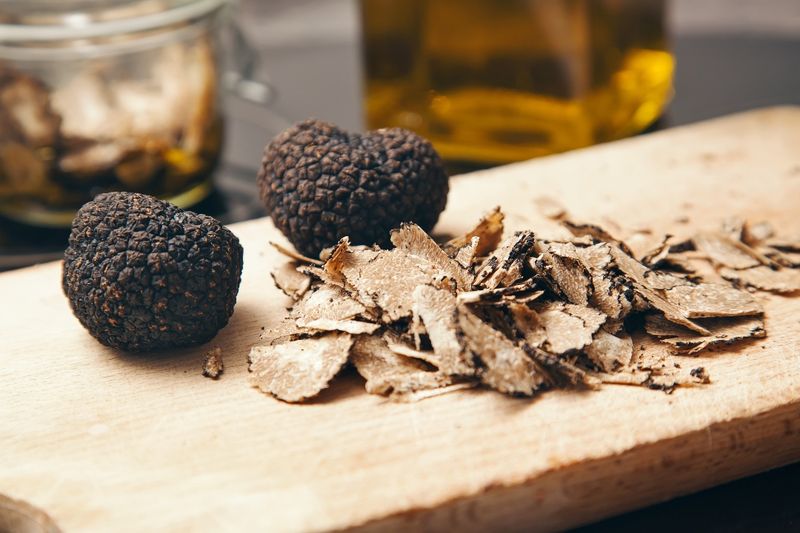Digging Deep
Indiana’s First Truffle Orchard Takes Root


By Lauren Bongard, with Marie Flanagan, North Central Region Sustainable Agriculture Research and Education (NCR-SARE), truffle farmer
Some farmers dream about bumper corn crops or perfect soybeans. Mimi and Evan Kokoska, however, dream about the nutty, earthy aroma of a freshly unearthed truffle — the fancy kind of fungus that hides underground and fetches hundreds of dollars a pound.
In Parke County, Indiana, the Kokoskas are betting on Burgundy truffles (Tuber aestivum) and a lot of patience.
Their venture, Koko Earth Farms, is home to Indiana’s first known large-scale truffle-hardwood orchard — and one of only about 200 truffle orchards in the entire United States. Their property holds more than 1,300 truffle-inoculated oak trees planted with the help of a $15,000 North Central Sustainable Agriculture Research and Education (NCR-SARE) grant. If all goes well, the payoff could be culinary gold, improved soil health and a whole new specialty crop industry in the Midwest.
“Truffles are highly prized for their umami aroma and flavor,” Mimi Kokoska says. “A supply of fresh truffles would improve market opportunities, soil health, food systems, quality of life, culinary and gastronomic experiences, agroforestry and tourism in the region.”
What Makes Truffles Special?
Indiana farmers are no strangers to mushrooms like morels, shiitakes and golden oysters. Truffles, however, are a different breed. They grow underground, forming a symbiotic relationship with tree roots exchanging nutrients for carbohydrates.
Unlike mushrooms, you can’t spot them on a walk through the woods. Instead, harvesters need trained dogs or pigs to sniff them out. In Europe, they’ve been prized for centuries. The Burgundy truffle is known for its nutty, earthy flavor and ability to thrive in cooler climates.
Their rarity makes them big business. Analysts expect the global truffle market to climb from $403 million in 2025 to more than $478 million by 2033. With the right preparation, local farmers in places such as Indiana can get a foothold in that market.
Planting for the Long Game
When the Kokoskas bought their land, the soil was serviceable for row crops. But truffles have higher standards. That meant amendments — and a lot of them.
In 2021, they applied 24 tons of lime per acre to their five-acre plot, mixing it with straw and planting a custom blend of grasses, legumes and forbs (broadleaf plants that are not grass-like) to build organic matter. They also made and applied leaf compost.
Nine months later, the pH hit truffle-friendly territory and calcium levels were up — a good sign for both the trees and fungi. In March 2022, the Kokoskas planted hundreds of oaks, all inoculated with Burgundy truffle spores. They spaced trees tighter than a standard orchard — less sunlight creates conditions that truffles like, more a forest floor than a farm field.
“We chose Burgundy truffles and Tuber canaliculatum — or Michigan truffle or Appalachian truffle — that’s native to this area because of our growth zone,” Mimi Kokoska explains “We needed a truffle that will survive and thrive with our cold winter temperatures and the type of host trees that grow in this area.”
The Kokoskas’ five-acre orchard demonstrates what’s possible when science meets agriculture.
While their exact planting density, irrigation system and pest-control methods are tailored to their site, others can apply the broader model — careful soil prep, inoculated trees and a multi-year commitment — almost anywhere the climate fits.
Irrigation, Weeds and Other Obstacles
Truffle orchards may sound romantic, but the Kokoskas’ first seasons were more sweat and stubborn weeds than wine and cheese.
After a wet spring, the summer of 2022 turned out to be one of the driest in a decade. Newly planted oaks don’t appreciate that kind of stress. Fortunately, the Kokoskas had installed a well and irrigation system.
Weeds, however, proved relentless. Invasive cockleburs emerged as public enemy number one. Hand-pulling before seeds set, shading through canopy closure and mulching with compost are now part of their annual battle plan.
Other pests arrived on the wing. Japanese beetles chewed through leaves in mid-summer, and organic sprays weren’t much help. The surprise winner? Non-pesticidal pheromone traps that drew beetles away from the trees without harming beneficial insects.
Beyond outside threats, the truffles themselves can fail.
Advice for Aspiring Truffle Growers
Clearly, truffles aren’t for impatient farmers — it can take six to 20 years before a tree produces its first marketable harvest. That means early mistakes can have long-lasting consequences.
From her experience so far, Mimi Kokoska offers a few pointers:
Learn from the pros. “We tried to learn as much as we could from other growers,” she shares. “Get as much education as possible, join truffle associations and talk to growers in as many stages of the work as possible. And sample truffles whenever you can!”
Soil prep is non-negotiable. Test, amend and retest. Truffles won’t grow in soil with the wrong pH range.
Think small with augers. A narrower auger fits oak roots better and helps with planting efficiency.
Plan for drought. Wet springs can turn bone-dry by July. Irrigation is a must.
Stake high. Taller, sturdier stakes help tubes and trees stand their ground, even in windy conditions.
Tackle weeds early. Once they seed, they’re a headache.
Build trust with your tree supplier. You won’t know for years if the inoculation worked, so vendor reliability is everything.
“We talked with people who had good experiences with our nursery, and that helped us feel good about where we were getting our inoculated trees from,” Mimi Kokoska says. “You’re putting in a lot of investment up front, so you want to make sure you’re partnering with a nursery that has rigid conditions so there’s less risk of contamination or failure.”
A Crop with Ecological Perks
Beyond the potential for high-value sales, truffles offer ecological benefits. They improve soil texture and nutrient cycling, strengthen tree health and contribute to wildlife food webs. In Oregon, for example, truffle-producing forests have supported struggling salmon habitats and provided carbon sequestration benefits.
Back in Indiana, the Kokoskas hope their orchard will not only yield truffles but also serve as a model for sustainable agroforestry.
What’s Next?
The five-acre orchard is only part of the Kokoskas’ vision — a vision that started the moment Mimi Kokoska tasted her first truffle.
“My first experience with truffles hit me like a ton of bricks,” she recalls. “I was visiting a friend in Paris, and he took me to his favorite restaurant. I had truffles for the first time there, and it was so striking. I went back for more the next night, and I was a little obsessed after that.”
Since then, she’s had the opportunity to taste them across the United States and in other countries, and her dream became to introduce others to the same local, high-quality truffles she experienced during that first lifechanging meal.
“Our goal is always to lift up and elevate the culinary availability of ingredients available in our area,” Mimi Kokoska explains. “Not just in Indiana, but all of the surrounding areas.”
She shares that multiple restaurants and chefs are already expressing interest in their local truffles, and that her farm is building relationships that will benefit the wider community once Koko Earth Farms begins harvesting.
Meanwhile, their work is already sparking collaboration. More than 70 farmers and 10 industry experts have visited the site, and the project has generated four new partnerships and additional grant funding.
The Takeaway
Indiana is better known for cornfields than truffles, but that could change in the coming decades. With careful soil preparation, strategic planting and a lot of patience, the Kokoskas are proving that this high-value crop has a place in Midwest agriculture.
It’s not a quick win. It’s not guaranteed. But if they succeed, Indiana’s truffle story won’t just be about one orchard — it could rewrite what’s possible in Midwest farming. And the payoff could be worth the wait for farmers, the environment and anyone lucky enough to shave fresh Burgundy truffles over their dinner plate.
Marie Flanagan, NCR-SARE, contributed to this story.

A Truffle Grower’s Quick Start Guide
Growing truffles is a long-term investment. That’s why the earliest steps matter most:
1. Test Your Soil — Then Test Again
Truffles need alkaline to neutral soil (pH 7.0–7.5) and high calcium levels. Most soils east of the Mississippi require lime amendments and organic matter to hit the target. Skip this step, and your truffles won’t stand a chance.
2. Choose the Right Trees
Burgundy truffles thrive with oaks and hazelnuts. Buy trees that have been professionally inoculated with truffle spores — and work with a reputable nursery, since results won’t show for years. Spacing trees tightly mimics a shady forest floor, which truffles love.
3. Have Patience
From planting to harvest, expect six to 20 years before you dig your first truffle.
4. Defend Against Nature
Protect young trees from deer and wind with tubes. Install irrigation before you plant and irrigate during drought spells. Keep weeds in check, especially aggressive invaders that steal nutrients and water from trees.
5. Learn the Art of the Hunt
Truffles grow inches below the surface, so harvest requires a trained nose — usually a dog — to detect them underground. Start training early so you’re ready to roll when the fungi finally arrive.
Remember Truffles aren’t just a crop; they’re an ecosystem partner. Treat your orchard as a long-term relationship with the land.
Tags:Country Journal

Acreage Life is part of the Catalyst Communications Network publication family.















